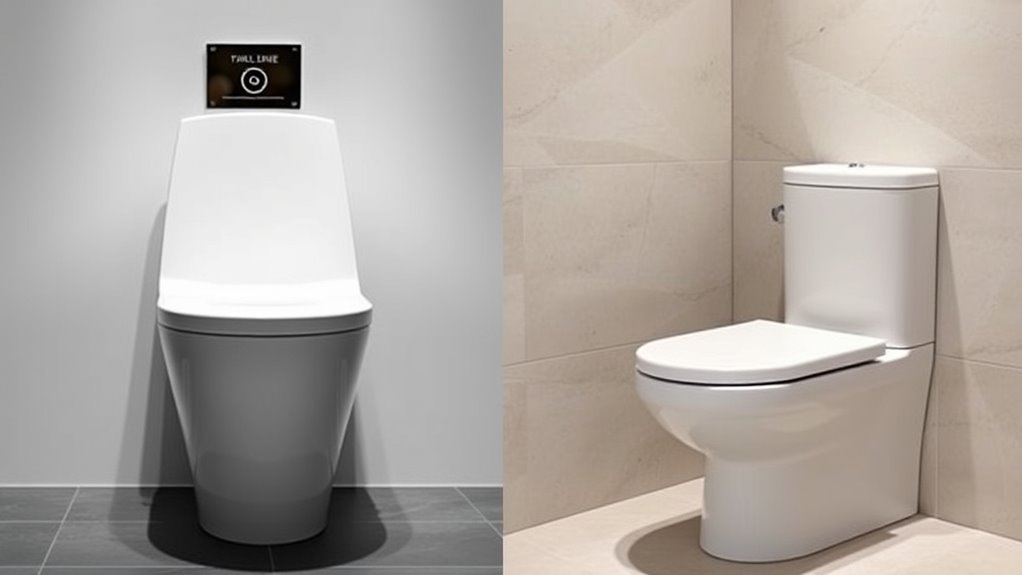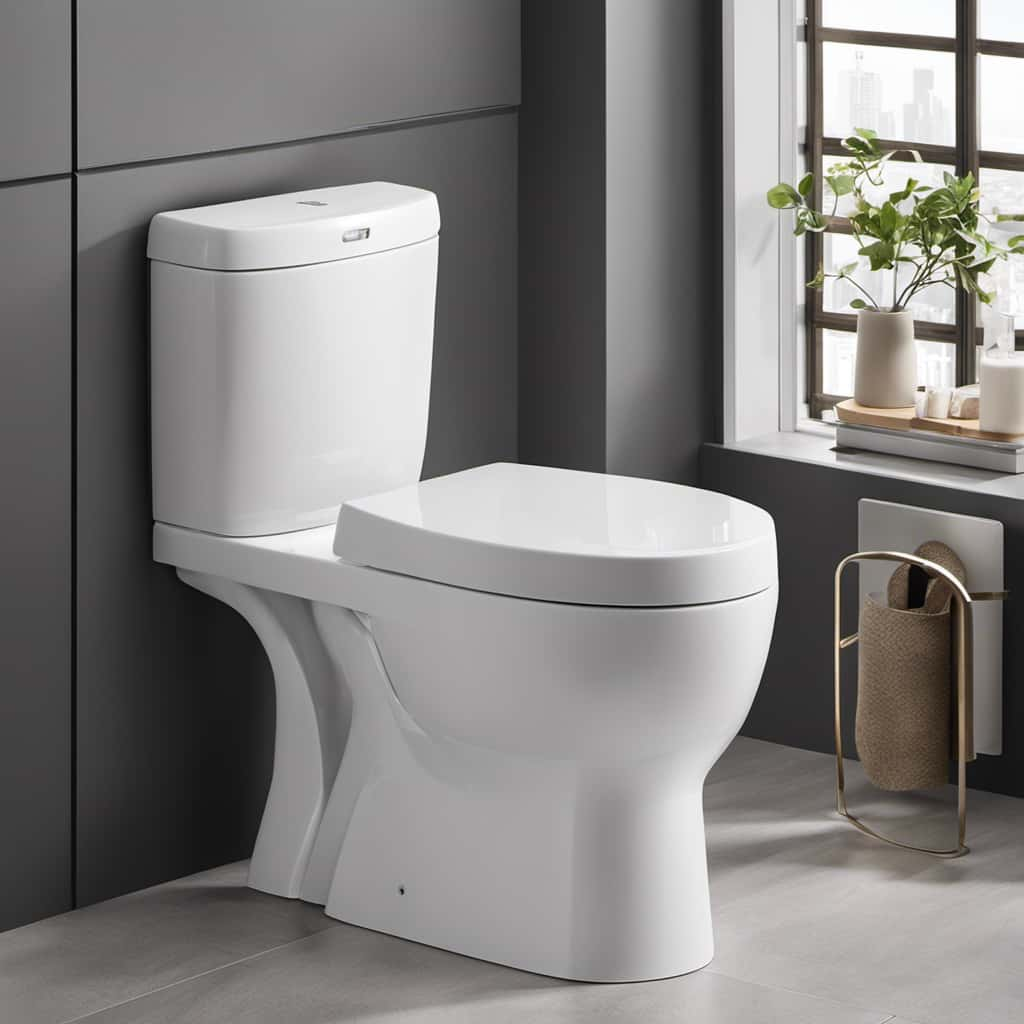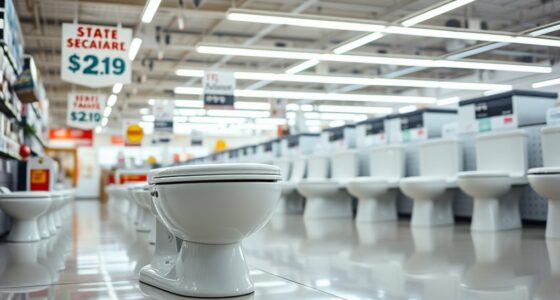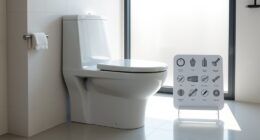When deciding between a one-piece and two-piece toilet, consider your style preference, maintenance needs, and budget. A one-piece offers a sleek look, easier cleaning, and simpler installation, but it’s often more expensive and heavier. A two-piece is usually more affordable, easier to repair, and allows for flexible replacement of parts. To find the best fit for your bathroom, explore the features and benefits of each option—more details can help you make an informed choice.
Key Takeaways
- One-piece toilets offer a sleek, modern look and easier cleaning due to fewer seams and crevices.
- Two-piece toilets are typically more affordable and allow easier replacement of individual components.
- Installation of one-piece models is usually quicker and simpler, but heavier weight can make positioning challenging.
- Two-piece toilets provide more repair flexibility, making it easier to replace or fix specific parts over time.
- Your choice depends on priorities like aesthetics, maintenance ease, installation complexity, and budget.

When you’re choosing a toilet for your bathroom, understanding the difference between a one-piece and a two-piece model is essential. Both types serve the same basic function, but they differ markedly in their design, installation process, and maintenance considerations. Knowing these differences helps you pick the best option for your needs and ensures smooth installation and upkeep.
Understanding the differences between one-piece and two-piece toilets helps you choose the right fit for your bathroom needs.
A one-piece toilet is crafted as a single, seamless unit, with the tank and bowl fused together. This design offers a sleek, modern look that can elevate your bathroom’s aesthetic. Because it’s all one piece, the installation process is usually quicker and simpler. You don’t have to worry about aligning separate parts or securing multiple components, which can save you time and effort during setup. However, keep in mind that one-piece toilets tend to be heavier, making them more challenging to move and position, especially in tight spaces. When it comes to maintenance considerations, a one-piece model generally has fewer crevices and seams where dirt and bacteria can hide. This makes cleaning easier and reduces the number of parts that may require repairs over time. The smooth surface also means less buildup of grime, which can be a noteworthy advantage if you prefer low-maintenance fixtures.
On the other hand, two-piece toilets consist of a separate tank and bowl, connected by bolts and gaskets. This design can be more traditional and often more affordable upfront. The installation process for a two-piece model usually involves attaching the tank to the bowl, which can be straightforward but might require more time and careful alignment compared to a one-piece. Because the parts are separate, you have more flexibility in replacing or repairing individual components if needed. This can be advantageous if you’re looking for a model with potentially easier repair options. Maintenance considerations for two-piece toilets include cleaning the area where the tank connects to the bowl, which can sometimes be a tricky spot for grime and buildup. Additionally, the seams and joints between the tank and bowl can harbor dirt, making regular cleaning more necessary to prevent mold or bacteria growth. Furthermore, advancements in toilet design have led to improved models that combine the benefits of both styles, offering ease of maintenance with sleek aesthetics.
Ultimately, your choice depends on your priorities. If you want a sleek, easy-to-clean toilet with quick installation, a one-piece model might be the best fit. If you prefer a potentially more affordable option with easier repairs and more flexibility in installation, a two-piece could suit you better. Both types have their advantages, so weigh your preferences for maintenance, installation, and style carefully before making your decision.
Frequently Asked Questions
Which Toilet Type Is More Environmentally Friendly?
A two-piece toilet is generally more eco-friendly because it often uses eco-friendly materials and offers better water-saving features. You can choose models with low-flow or dual-flush systems, reducing water consumption markedly. While one-piece toilets might look sleeker, two-piece models tend to be easier to upgrade with water-efficient technologies. By selecting a two-piece toilet with these features, you help conserve water and minimize your environmental impact.
How Does Water Efficiency Compare Between One-Piece and Two-Piece Toilets?
Water efficiency is comparable between one-piece and two-piece toilets, but tank design and flushing mechanisms make a difference. You’ll find that modern models, regardless of type, use less water per flush thanks to dual-flush options and advanced mechanisms. While both designs can be eco-friendly, look for toilets with low GPF (gallons per flush) ratings. This way, you save water without sacrificing performance, making your bathroom both green and efficient.
Are There Significant Differences in Installation Time?
You’ll find that installation time varies mainly because of installation complexity and plumbing requirements. One-piece toilets tend to be quicker to install since they’re a single unit, reducing parts and assembly. Two-piece toilets usually take longer, as you need to connect the tank and bowl properly. Your familiarity with plumbing also impacts installation speed—if you’re experienced, the difference shrinks. Overall, expect a shorter install with a one-piece model.
Which Style Is Better for Small Bathrooms?
If you’re limited on space, a one-piece toilet often proves to be the better choice. It offers a sleek, compact design that fits seamlessly into small bathrooms, maximizing space considerations. Plus, its streamlined aesthetic appeal enhances the overall look, making your bathroom feel more open and modern. While installation might take a bit longer, the benefits of saving space and creating a clean, cohesive look make it worth considering.
How Do Maintenance and Cleaning Differ?
Cleaning is easier with a one-piece toilet because its seamless design means fewer crevices where dirt and grime can hide. You’ll likely find maintenance requires less frequent attention since buildup is easier to spot and remove. A two-piece toilet, with its separate tank and bowl, may need more regular cleaning and tighter maintenance to prevent leaks or stains. Overall, a one-piece toilet simplifies cleaning ease and reduces maintenance frequency.
Conclusion
Ultimately, choosing between a one-piece and two-piece toilet comes down to your needs and style. Think of it like a blank canvas—each option offers its own advantages, shaping your bathroom’s look and function. Remember, the right choice can transform your space from ordinary to extraordinary. So, weigh your priorities, visualize your ideal bathroom, and make a decision that feels right. After all, your bathroom deserves a touch of perfection—don’t settle for anything less.









